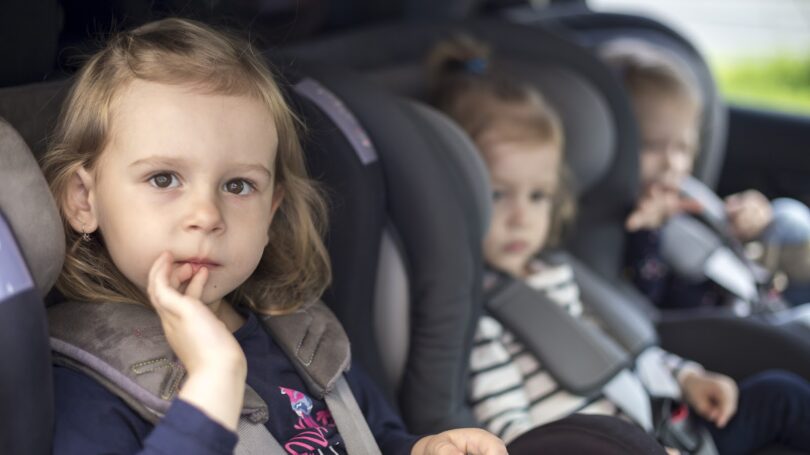Should you replace your child’s car seat after a crash? This is a question that weighs heavily on the minds of many parents post-accident. Understanding the safety implications of a car seat replacement, especially after a moderate or severe crash, is vital to ensuring your child’s continued protection.
The National Highway Traffic Safety Administration (NHTSA) reported that child safety seats, including booster seats, played a significant role in saving the lives of 325 children under the age of five in a single year. Even though car seats are effective, car crashes remain a leading cause of injury and death for children aged 1 to 13. That’s why it’s important for parents and caregivers to choose the right child restraint, follow the car seat manual closely, and replace car seats after a crash, especially if there is visible damage or if the crash involved enough force to compromise the seat’s integrity.
In this blog, we’ll learn the importance of a child’s car seat and replacement after an accident, navigate insurance claims for damaged seats, and understand when legal assistance might be needed.
Impact of a Car Crash on Child Car Seats
Car crashes can significantly impact child car seats, and it’s important to understand the potential consequences for the child’s safety. Here are some key points to consider:
Visible Damage
After a car crash, inspecting the child’s car seat for any visible damage is crucial. Look for cracks, bends, or other signs of structural damage. If the seat has any visible damage, it may compromise its effectiveness in future crashes.
Invisible Damage
Not all damage is visible to the naked eye. Internal components of child car seats, such as the energy-absorbing foam, seat belts, and child restraints, may be compromised even if the seat appears intact. Car seat manufacturers recommend replacing child restraints after a moderate or severe crash to ensure the seat functions correctly in future collisions.
Guidelines from Manufacturers
Car seat manufacturers provide detailed guidelines for replacing child seats after a crash, particularly after moderate or severe crashes. It’s important to consult the car seat manual for the specific seat involved, as some car seat manufacturers suggest replacing the seat even after a minor crash. Following the NHTSA’s guidelines is also imperative to ensure your child’s safety.
Insurance Coverage
In some cases, car insurance companies may cover replacing child car seats involved in a crash. Check with your insurance provider to understand their policies regarding car seat replacement.
Child’s Safety
The primary purpose of a child safety seat is to protect child passengers during a collision. If you suspect any damage, whether visible or not, the safest choice is to replace the car seat. A damaged car seat may not offer the same level of protection in future crashes, putting the child at greater risk of injury. This includes scenarios where airbags deployed or the vehicle door nearest to the child’s seat was damaged.
Proper Installation
Even after replacing a car seat, it is important to install the new seat correctly. Follow the car seat manufacturer’s instructions to make sure the new car seat, booster seat, or safety seat is securely fastened. Properly installed child restraints help protect vehicle occupants by absorbing crash energy and reducing injuries.
NHTSA Recommendations and Criteria for Car Seat Replacement

In cases of a minor crash or fender bender, NHTSA guidelines suggest checking for damage that may not be visible to the naked eye. Factors such as whether airbags deployed, the condition of the vehicle door nearest to the child’s car seat, or any damage to the plastic shell or tether strap should all be evaluated before reusing the seat. While some child car seats might seem unharmed after minor vehicle crashes, It’s important to be cautious. NHTSA recommends replacing a car seat after any collision that exceeds their specific criteria.
The National Highway Traffic Safety Administration (NHTSA) provides car seat recommendations for children based on age and size. Here is a summary of their guidelines:
Rear-Facing Car Seat
- Age: Birth – 12 Months
- Recommendation: Children under age one should always ride in a rear-facing car seat. Options include infant-only seats or convertible/all-in-one seats with higher height and weight limits for extended rear-facing use.
- Duration: Keep the child rear-facing as long as possible until the seat’s height or weight limit is reached.
Forward-Facing Car Seat
- Age: 1 – 3 Years
- Recommendation: Continue using a rear-facing car seat until the child reaches the manufacturer’s height or weight limit. Transition to a forward-facing car seat with a harness and tether when ready.
- Duration: Use the forward-facing car seat until the child outgrows the harness limits.
Booster Seat
- Age: 4 – 7 Years
- Recommendation: Keep the child in a forward-facing car seat with a harness and tether until the seat’s height or weight limit is reached. Then, transition to a booster seat placed in the back seat.
- Duration: Continue using a booster seat until the child is big enough to fit properly in a seat belt.
Seat Belt
- Age: 8 – 12 Years
- Recommendation: Keep the child in a booster seat until they are big enough for seat belts to fit properly. The lap belt should fit and lie across the upper thighs, not the stomach, and the shoulder belt should snugly across the shoulder and chest, not the neck or face.
- Duration: Even when using a seat belt, the child should continue to ride in the back seat for safety.
Steps to Take After a Car Accident Involving a Child Passenger

The moments following a car accident can be chaotic and stressful, especially when there’s a child passenger involved. As an adult in this situation, you need to know what steps need immediate action.
1. Prioritize the Safety of All Vehicle Occupants
Your first action should ensure everyone inside the vehicle is safe from harm or injury after experiencing crash forces. If any injuries are apparent, dial 911 immediately without delay.
In cases where your child was strapped into their safety seat during the incident, it becomes crucial that you inspect said car seat meticulously for signs of damage or wear, which could compromise its effectiveness.
NHTSA guidelines suggest even minor accidents may require replacement due to unseen structural damages affecting future crash protection capabilities.
2. Report the Incident to Authorities and Insurance Companies
Contacting local authorities at the crash site after an accident serves two primary purposes: they will document details about motor vehicle crashes, which might prove helpful later when dealing with insurance companies; secondly, they ensure all parties involved receive necessary assistance promptly, if required.
A car crash can be a terrifying experience, mainly when kids are present. The safety of your little ones is paramount. The NHTSA recommends guidelines emphasizing the importance of replacing child safety seats after any accident for optimal protection.
Dealing with damaged car seats post-accident involves proper disposal methods and obtaining replacements promptly. Car insurance companies play their part, too, with laws like those in Nevada ensuring they cover the cost of new car seats after a crash.
Selecting an appropriate and specific car seat based on age, weight, and height, and installing it correctly is vital for future protection against crashes. A properly installed seat significantly reduces the risk of fatal injuries during subsequent accidents involving young children.
If legal disputes arise over accident liability or insurance claims following an incident involving child passengers, do not hesitate to seek professional assistance from car-accident attorneys. Schedule a consultation with our team at Temple Injury Law.

Jeff Temple focuses his practice in the area of personal injury. As a skilled personal injury attorney, he handles a broad range of cases including motor vehicle accidents, premises liability, and wrongful death. He is a graduate of the Radford University, he later attended the University of Miami School of Law and studied abroad at University College London. Upon graduating, Jeff relocated to Las Vegas and founded Temple Injury Law in 2022.

